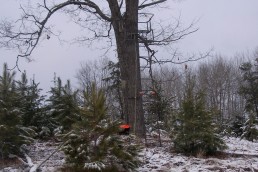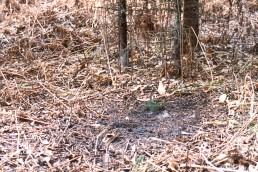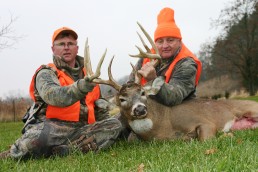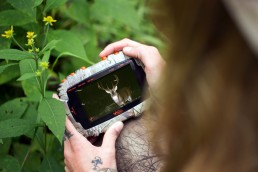Best November Stand Sites
SHARE THIS POST
Most whitetail hunters miss using the most productive of stand sites during November. In my home state of Minnesota, our firearm deer-hunting season closely spans the two-week primary breeding phase of the rut when 85 percent of does are bred. Seemingly, it’s logical to use buck lures containing doe urine and doe-in-heat pheromone to attract antlered bucks during this period—most hunters are not particularly concerned with locating stand sites, where the odds of seeing unsuspecting bucks within easy shooting range may be superior. This alone is one of several reasons doe-in-heat-type buck lures are not as effective as hunters hope they will be.
There are other reasons.
While breeding is in progress, most most antlered bucks have been temporarily run off by the most dominant buck of each 1- to 2-square-mile area normally inhabited by whitetails, meaning, fewer bucks will be in the area. Throughout this two-week period the dominant breeding buck is especially busy—accompanying does in heat, breeding, battling and running off other bucks that dared to return early. Only under rare circumstances do they take time to renew ground scrapes during this period. Moreover, while breeding is in progress, dominant breeding bucks do not abandon does they are accompanying to investigate other sources of airborne doe-in-heat pheromone. Other does in heat must find the breeding bucks. Then, after November breeding comes to an end, dominant breeding bucks generally remain up to two weeks in seclusion in their summer bedding areas, getting much needed rest.
On top of all this, since the late 1980s, most bucks 2-1/2 years of age or older have learned to recognize the danger of approaching any source of airborne doe-in-heat pheromone accompanied by airborne human odors originating from hunters waiting nearby in ambush. This does not mean buck lures containing pheromone are no longer capable of luring bucks to stand sites. When used properly, it still can be done, but there is a much more productive way to hunt antlered bucks and other deer in November: stand-hunting at current favorite whitetail feeding areas.
Back in the September issue of MidWest Outdoors I explained how to identify feeding areas frequented by antlered bucks and other deer during that month and into October. Where I hunt in northern Minnesota—and doubtless where you hunt forest deer as well—whitetails suddenly switch from eating greens (grasses, clover, leaves, etc.) to eating tender stems of certain woody plants in early November, collectively known as “browse.” Not uncommonly, favorite areas where abundant browse is located are distant from areas where whitetails had been previously feeding on greens (some favorite feeding areas have both greens and browse). Areas that were recently logged, clearcuts, soon become rich sources of favorite browse plants. But whitetails, 2 1/2 years of age or older, tend to be so cautious and alert when feeding in open areas like clearcuts that the least threat by human hunters quickly prompts them to abandon them. For this reason, by day 2 or 3 of a hunting season, most experienced whitetails will limit feeding to areas where they are not readily seen while feeding. Such areas are easily overlooked.
One of my favorite spots to hunt feeding whitetails in November is a narrow valley smothered by grass tall enough to hide feeding deer. What makes this spot a favorite browse area is an abundance of much favored red-bark dogwoods (red osiers), which can hardly be seen among the grasses. Another favorite spot is a densely wooded slope so full of osiers and red-stemmed sugar maple saplings (which whitetails also relish) that the entire hillside appears red in morning sunlight. Another favorite is a quarter-moon-shaped, densely forested area loaded with osiers and gray-barked mountain maples, wrapped around the eastern tip of a wet spruce bog. Another feeding area that annually attracts deer, and me, is a winding hillside bench of acorn-bearing red oaks. I took a buck at this spot two years ago. My sons Ken and Dave have taken quite few a bucks in similar stands of red oaks northwest of this site. Still another favorite browse area I rarely miss hunting is a hill covered with gray red oak saplings and thin stems of blueberry plants barely tall enough to poke up through 6 inches of snow.
Chances area, browse plants favored by the deer you hunt in November are quite different from favorite browse plants of the whitetails I hunt. Nonetheless, by the second week in November, deer sign make all current favorite browse areas obvious.
Are you enjoying this post?
You can be among the first to get the latest info on where to go, what to use and how to use it!
Here’s what to look for: An area with an unusual number of off-trail deer tracks, most of them 3 inches or less in length; lots of tracks close together, typically less than 18 inches apart, zigzagging; lots of off-trail deer droppings, most of them 1/2 inch or less in length; ragged, white tips of twigs and slender branches on woody, deer tall saplings, young trees, bushes and suckers (stems growing from stumps); spoke-like deer trails entering the area; and a deer trail or series of trails closely ringing the area in adjacent forest cover.
If a mature buck is your intended quarry, keep your eyes pealed for fresh, less common tracks 3 1/2 to 4 inches long and droppings 3/5 to 1 inch or more in length near a known browse area. If snow covers the ground and you discover tracks of a deer dragging its hooves from track to track, you are looking at tracks of a buck under the influence of doe-in-heat pheromone. This buck is likely to be seen accompanying a doe feeding in the nearest browse area during the current or next period of feeding. Does are only in heat 24 to 26 hours, so begin hunting adjacent to the browse area where such hoof prints are found very soon.
Never stand-hunt at the very edge of a browse area after leaves have fallen. Sit back in the woods about 15 to 20 yards from the edge using natural, unaltered cover to hide your body and necessary movements (at ground level or in a tree). Make no shooting lanes; use natural openings (windows through cover) instead.
Hunt downwind in the morning (deer will already be there feeding) and crosswind in the afternoon or evening (deer will approach later from downwind).
If a desirable quarry is not seen feeding at a browse area within two days, don’t hesitate to move to another well-tracked browse area, especially where fresh tracks and droppings of a mature buck are found. If you don’t know the whereabouts of another browse area, plan some serious pre-season scouting for them next fall (areas with lots of browse plants with blackened tips caused by browsing during the previous winter).
Finally, be patient while hunting such an area. All of the enormous number of deer trails in your hunting area lead to current favorite browse areas in November, where movements of visible deer are thus concentrated. Whether breeding is in progress or not, your odds of spotting a desirable quarry early or late in the day at a current favorite browse area will be no less than 12 times greater than spotting such a deer on any distant deer trail.
Dr. Ken Nordberg has written more than 700 magazine articles and 12 books on the habits and hunting of whitetails and black bears, including the “Whitetail Hunters Almanac” series. He also produced “Doc’s Buck and Bear Hunting School” videos. His encyclopedic website is: drnordbergondeerhunting.com.
MWO
SHARE THIS POST
Did you enjoy this post?
You can be among the first to get the latest info on where to go, what to use and how to use it!
Dr. Ken Nordberg
Based on his 55 years of field research, Dr. Ken Nordberg has written more than 800 magazine articles, 12 books on whitetails—including the famous Whitetail Hunter’s Almanac series—five books on black bear hunting and produced Buck and Bear Hunting School videos. You may peruse his encyclopedic website with whitetail hunting tips: drnordbergondeerhunting.com, his blog: drnordbergondeerhunting.wordpress.com, or social media pages.



